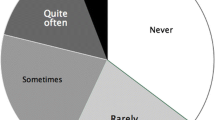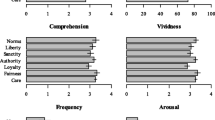Abstract
Humans frequently interact with strangers absent prior direct experience with their behavior. Some conjecture that this may have favored evolution of a cognitive system within the hominoid clade or perhaps the primate order to assign reputations based on third-party exchanges. However, non-primate species’ acquisition of skills from experienced individuals, attention to communicative cues, and propensity to infer social rules suggests reputation inference may be more widespread. We utilized dogs’ sensitivity to humans’ social and communicative cues to explore whether dogs evidenced reputation-like inference for strangers through third-party interactions. Results indicated dogs spontaneously show reputation-like inference for strangers from indirect exchanges. Further manipulations revealed that dogs continued to evidence this ability despite reduction of specific components of the observed interactions, including reduction of visual social cues (i.e., face-to-face contact between the participants in the interaction) and the nature of the recipient (i.e., living, animate agent versus living, inanimate self-propelled agent). Dogs also continued to demonstrate reputation-like inference when local enhancement was controlled and in a begging paradigm. However, dogs did not evidence reputation-like inference when the observed interaction was inadvertent.



Similar content being viewed by others
References
Alexander RD (1987) The biology of moral systems. Aldine de Gruyter, New York
Amy M, Leboucher G (2007) Male canaries can visually eavesdrop on conspecific food interactions. Anim Behav 74:57–62
Axelrod R (1984) The evolution of cooperation. Basic Books, New York
Bekoff M (1995) Play signals as punctuation: the structure of social play in canids. Behaviour 132:420–429
Brosnan SF, de Waal FBM (2003) Monkeys reject unequal pay. Nature 425:297–299
Bshary R, Grutter AS (2006) Image scoring and cooperation in a cleaner fish mutualism. Nature 22:975–978
Call J, Tomasello M (1998) Distinguishing intentional from accidental actions in orangutans, chimpanzees, and human children. J Comp Psychol 112:192–206
Call J, Hare B, Carpenter M, Tomasello M (2004) ‘Unwilling’ versus ‘unable’: chimpanzees understanding of human intentional action. Dev Sci 7:488–498
Cooper JJ, Ashton C, Bishop S, West R, Mills DS, Young RJ (2003) Clever hounds: social cognition in the domestic dog (Canis familiaris). Appl Anim Behav Sci 81:229–244
Danchin E, Giraldeau LA, Valone TJ, Wagner RH (2004) Public information: from nosy neighbors to cultural evolution. Science 305:487–491
Grosenick L, Clement TS, Fernald RD (2007) Fish can infer social rank by observation alone. Nature 445:429–432
Hare B, Tomasello M (2005) Human-like social skills in dogs? Trend Cogn Sci 9:439–444
Hare B, Brown M, Williamson C, Tomasello M (2002) The domestication of social cognition in dogs. Science 298:1634–1636
Hauser MD, Chen MK, Chen F, Chuang E (2003) Give unto others: genetically unrelated cotton-top tamarin monkeys preferentially give food to those who altruistically give food back. Proc R Soc Lond B Biol Sci 270:12137–12139
Herman LM, Abichandani SL, Elhajj AN, Herman EYK, Sanchez JL, Pack AA (1999) Dolphins (Tursiops truncatus) comprehend the referential character of the human pointing gesture. J Comp Psychol 113:347–364
Horowitz A (2009) Attention to attention in domestic dog (Canis familiaris) dyadic play. Anim Cogn 12:107–118
Kaminski J, Riedel J, Call J, Tomasello M (2005) Domestic goats, Capra hircus, follow gaze direction and use social cues in an object choice task. Anim Behav 69:11–18
McGregor PK, Dabelsteen T (1996) Communications networks. In: Kroodsma DE, Miller EH (eds) Ecology and evolution of acoustic communication among birds. Cornell University Press, Ithaca, pp 409–425
Melis AP, Hare B, Tomasello M (2006) Chimpanzees recruit the best collaborators. Science 311:1297–1300
Miklósi Á, Soproni K (2006) A comparative analysis of animals’ understanding of the human pointing gesture. Anim Cogn 9:81–93
Miklósi Á, Topál J, Csányi V (2004) Comparative social cognition: what can dogs teach us? Anim Behav 67:995–1004
Parejo D, Aviles JM (2007) Do avian brood parasites eavesdrop on heterospecific sexual signals revealing host quality? A review of the evidence. Anim Cogn 10:81–88
Povinelli DJ, Perilloux HK, Reaux JE, Bierschwale DT (1998) Young and juvenile chimpanzees’ (Pan troglodytes) reactions to intentional versus accidental and inadvertent actions. Behav Process 42:205–218
Reid P (2009) Adapting to the human world: dogs’ responsiveness to our social cues. Behav Process 80:325–333
Rooney NJ, Bradshaw JWS (2006) Social cognition in the domestic dog: behavior of spectators towards participants in interspecific games. Anim Behav 72:343–353
Schwab C, Huber L (2006) Obey or not obey? Dogs (Canis familiaris) behave differently in response to attentional states of their owners. J Comp Psychol 120:169–175
Seabright P (2005) In the company of strangers. Princeton University Press, Princeton
Subiaul F, Vonk J, Okamoto-Barth S, Barth J (2008) Do chimpanzees learn reputation by observation? Evidence from direct and indirect experience with giving and withholding strangers. Anim Cogn 11:611–623
Thorpe WH (1956) Learning and instinct in animals. Methuen and Company, London
Topál J, Miklósi Á, Gácsi M, Dóka A, Pongrácz P, Kubinyi E, Virányi Z, Csányi V (2009) The dog as a model for understanding human social behavior. In: Brockmann H, Roper T, Naguib M, Wynne-Edwards K, Mitani J, Simmons L (eds) Advances in the study of behavior, vol 39. Elsevier, San Diego, pp 1–57
Vas J, Topál J, Gácsi M, Miklósi Á, Csányi V (2005) A friend or an enemy? Dogs’ reaction to an unfamiliar person showing behavioural cues of threat and friendliness at different times. Appl Anim Behav Sci 94:99–115
Zentall TR (2006) Imitation: definitions, evidence, and mechanisms. Anim Cogn 9:335–353
Acknowledgments
Author order for the first and second author was determined by coin toss. The first and second author share equal authorship credit on this paper. We would like to thank Chelsea Taglang, Sherry McClurkin, Robin Reutten, Chelsea Wolke, Ayelet Baruch, Jessica Arbuthnot, Rebecca German, and Meghan Tomlin for their assistance. We would also like to thank the dogs and dog owners that participated. The experiments reported comply with all current laws in the United States. We have no conflicts of interest to report.
Author information
Authors and Affiliations
Corresponding author
Rights and permissions
About this article
Cite this article
Kundey, S.M.A., De Los Reyes, A., Royer, E. et al. Reputation-like inference in domestic dogs (Canis familiaris). Anim Cogn 14, 291–302 (2011). https://doi.org/10.1007/s10071-010-0362-5
Received:
Revised:
Accepted:
Published:
Issue Date:
DOI: https://doi.org/10.1007/s10071-010-0362-5




